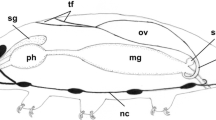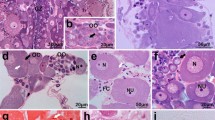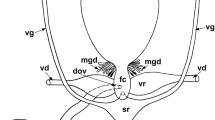Abstract
The histological and ultrafine organization of the female reproductive system of Acanthocephalus tenuirostris (Achmerov et Dombrowskaja-Achmerova 1941) was studied. A fragmented ovary (ovarian balls) is shown to consist of somatic (syncytial) and germinal (symplastic or syncytial) components. Oocytes are separated from the germinal syncytium remaining surrounded by the somatic syncytium, fertilized, and surrounded with a fertilization envelope. Then, most zygotes move into the body lumen and continue develo** in a free state; however, some of them may develop inside the ovarian ball for some time and even form the outer element of an embryonic shell (E1) on the surface of the fertilization envelope. The walls of the uterine bell, oviducts, and uterus are found to be formed by a unique two-layer tissue, the outer layer of which is represented by myofilaments, and the inner layer of which is cytoplasm with predominating mitochondria; the formation of intercellular material is characteristic of this tissue. The nuclei of this tissue are characterized by signs of nuclear secretion similar to the nuclei of some muscle cells of the acanthocephalans. The uterine wall is shown to be discontinuous, being represented by several large blocks of similar tissue separated by narrow spaces with intercellular material. Such a structure does not correspond to the existing opinion on the symplastic organization of the uterus.





Similar content being viewed by others
REFERENCES
Anantaraman, S. and Subramoniam, T., Oogenesis in Acanthosentis oligospinus n. sp., an acanthocephalan parasite of the fish, Macrones gulio, Proc. Indian Acad. Sci., B, 1975, vol. 82, pp. 139–145.
Asaolu, S., Morphology of the reproductive system of female Moniliformis dubius (Acanthocephala), Parasitology, 1980, vol. 81, no. 2, pp. 433–446.
Asaolu, S., Whitfield, P.J., Crompton, D.W.T., and Maxwell, L., Observations on the development of ovarian balls of Moniliformis (Acanthocephala), Parasitology, 1981, vol. 83, no. 1, pp. 23–32.
Atkinson, K.H. and Byram, J.E., The structure of the ovarian ball and oogenesis in Moniliformis dubius (Acanthocephala), J. Morphol., 1976, vol. 148, no. 2, pp. 391–426.
Atrashkevich, G.I., Orlovskaya, O.M., Regel’, K.V., Mikhailova, E.I., and Pospekhov, V.V., Parasitic worms of the animals of the Taui Bay, in Biologicheskoe raznoobrazie Tauiskoi guby Okhotskogo moray (Biological Diversity of the Taui Bay of the Sea of Okhotsk), Chereshnev, I.A., Ed., Vladivostok: Dal’nauka, 2005, pp. 175–251.
Chereshnev, I.A., Nazarkin, M.V., Shestakov, A.V., Skopets, M.B., and Grunin, S.I., Marine and freshwater fish of the Tauiskaya Bay, in Biologicheskoe raznoobrazie Tauiskoi guby Okhotskogo morya (Biological Diversity of the Tauiskaya Bay of the Sea of Okhotsk), Chereshnev, I.A., Eds., Vladivostok: Dal’nauka, 2005, pp. 545–575.
Van Cleave, H.J., Acanthocephala of North American mammals, Illinois Biol. Monogr., 1953, vol. 23, pp. 1–179.
Crompton, D.W.T., Reproduction, in Biology of the Acanthocephala, Crompton, D.W.T. and Nickol, B.B., Eds., Cambridge: Cambridge University Press, 1985, pp. 213–271.
Crompton, D.W.T. and Whitfield, P.J., Observations on the functional organization of the ovarian balls of Moniliformis and Polymorphus (Acanthocephala), Parasitology, 1974, vol. 69, no. 3, pp. 429–443.
Crook, J.R. and Grundmann, A.W., The life history and larval development of Moniliformis clarki (Ward, 1917), J. Parasitol., 1964, vol. 50, no. 5, pp. 689–693.
Davydenko, T.V. and Nikishin, V.P., Study of the reproductive system of the female Acanthocephalus tenuirostris, in Chteniya pamyati akademika K.V. Simakova (Lectures in Memory of Academician K.V. Simakov), Goryachev, N.A., Ed., Magadan: Severo-Vostochnyi Kopleksn. Nauchno-Issled. Inst. Dal’nevost. Otd. Ross. Akad. Nauk, 2017, pp. 124–126.
Davydenko, T.V. and Nikishin, V.P., Organization of female and male reproductive systems of Acanthocephalus tenuirostris, in Bioraznoobrazie parazitov. Trudy Tsentra parazitologii (Biodiversity of Parasites. Transactions of the Center of Parasitology), Movsesyan, S.O., Ed., Moscow: KMK, 2018, vol. 50, pp. 78–79.
Guraya, S.S., Histochemical observations on the develo** acanthocephalan oocyte, Acta Embryol. Exp., 1969, vol. 1, no. 2, pp. 147–155.
Herlyn, H. and Röhrig, H., Ultrastructure and overall organization of ligament sac, uterine bell, uterus and vagina in Paratenuisentis ambiguous (Acanthocephala, Eoacanthocephala)—the character evolution within the Acanthocephala, Acta Zool. (Stockholm), 2003, vol. 84, no. 3, pp. 239–247.
Ivanova-Kazas, O.M., Sravnitel’naya embriologiya bespozvonochnykh zhivotnykh. Prosteishie i nizshie mnogokletochnye (Comparative Embryology of Invertebrates. Protozoa and Lower Metazoa), Novosibirsk: Nauka, 1975.
Kusenko, K.V. and Nikishin,V.P., Organization of ligament of acanthocephalan Neoechinorhynchus beringianus Mikhailova et Atrashkevich, 2008 (Acanthocephala, Eoacanthocephala), Inland Water Biol., 2017, vol. 10, no. 2, pp. 140–144.
Marchand, B., The elaboration of the acanthor shell of Acanthosentis acanthuri (Acanthocephala), J. Parasitol., 1984, vol. 70, no. 5, pp. 712–718.
Marchand, B. and Mattei, X., Presence de flagelles spermatiques dans les spheres ovariennes des eoacanthocephales, J. Ultrastruct. Res., 1976, vol. 56, no. 3, pp. 331–338.
Marchand, B. and Mattei, X., Fertilisation in Acanthocephala. II. Spermatozoon penetration of oocyte, transformation of gametes and elaboration of the fertilization membrane, J. Submicrosc. Cytol., 1980, vol. 12, no. 1, pp. 95–105.
Meyer, A., Das urogenitale Organ von Oligacanthorhynchus taenioides (Diesing) ein neuer Nephridialtypus bein den Acanthocephalen, Z. Wiss. Zool., Abt. A, 1931, vol. 138, pp. 88–98.
Meyer, A., Acanthocephala, Dr H. G. Bronn’s Klassen und Ordnungen des Tierreichs, 1933, vol. 4, pp. 333–582.
Nicholas, W.L., The biology of the Acanthocephala, Adv. Parasitol., 1967, vol. 5, pp. 205–246.
Nicholas, W.L. and Hynes, H.B.N., The embryology of Polymorphus minutus (Goeze, 1972) (Acanthocephala), Proc. Zool. Soc. London, 1963, vol. 141, no. 4, pp. 791–801.
Nikishin, V.P., Structure and formation of embryonic membranes in acanthocephalans Arhythmorhynchus petrochenkoi, Parazitologiya, 1995, vol. 29, no. 5, pp. 398–403.
Nikishin, V.P., “Nuclear secretion” in giant muscle cells of the acanthocephalan Filicollis anatis, Tsitologiya, 2000, vol. 42, no. 5, pp. 429–431.
Nikishin, V.P., Subsurface musculature of spiny-headed worms (Acanthocephala) and its role in formation of intercellular matrix, Biol. Bull. (Moscow), 2004, vol. 31, no. 6, pp. 598–612.
Nikishin, V.P. and Krasnoshchekov, G.P., Micromorphology of the “central nuclear mass” of Acanthocephalan Polymorphus magnus acanthors, Tsitologiya, 1986, vol. 28, no. 11, pp. 1261–1263.
Parshad, V.R. and Crompton, D.W.T., Aspects of acanthocephalan reproduction, Adv. Parasitol., 1981, vol. 19, pp. 73–138.
Parshad, V.R. and Guraya, S.S., Morphological and histochemical observations on the ovarian balls of Centrorhynchus corvi (Acanthocephala), Parasitology, 1977, vol. 74, pp. 243–253.
Parshad, V.R. and Guraya, S.S., Morphological and histochemical observations on oocyte atresia in Centrorhynchus corvi (Acanthocephala), Parasitology, 1978, vol. 77, no. 2, pp. 133–138.
Petrochenko, V.I., Akantotsefaly (skrebni) domashnikh i dikikh zhivotnykh (Acanthocephalans (Acanthocephala) of Domestic and Wild Animals), Moscow: Akad. Nauk SSSR, 1956, vol. 1.
Reynolds, E.S., The use of lead citrate at high pH as an electronopaque stain in electron microscopy, J. Cell Biol., 1963, vol. 40, pp. 43–44.
Whitfield, P.J., A histological description of the uterine bell of Polymorphus minutus (Acanthocephala), Parasitology, 1968, vol. 58, pp. 671–682.
ACKNOWLEDGMENTS
We express our sincere gratitude to E.M. Skorobrekhova and K.V. Kusenko for assistance in electron microscopic studies.
Funding
This study was carried out under a State Assignment on the topic “Taxonomic, Morphological, and Ecological Diversity of Helminths of Vertebrate Animals of North Asia,” project no. AAA-A17-117012710031-6.
Author information
Authors and Affiliations
Corresponding authors
Ethics declarations
Conflict of interest. The authors declare that they have no conflicts of interest.
Statement on the welfare of animals. All applicable international, national, and/or institutional guidelines for the care and use of animals were followed.
Additional information
“The ovarian balls … are one of the most interesting and unusual features of the Acanthocephala” (Parshad and Crompton, 1981)
Translated by M. Batrukova
Rights and permissions
About this article
Cite this article
Davydenko, T.V., Nikishin, V.P. Features of Tissue Organization in the Female Reproductive System of Acanthocephalus tenuirostris (Palaeacanthocephala, Echinorhynchida). Biol Bull Russ Acad Sci 50, 1556–1566 (2023). https://doi.org/10.1134/S106235902307004X
Received:
Revised:
Accepted:
Published:
Issue Date:
DOI: https://doi.org/10.1134/S106235902307004X




